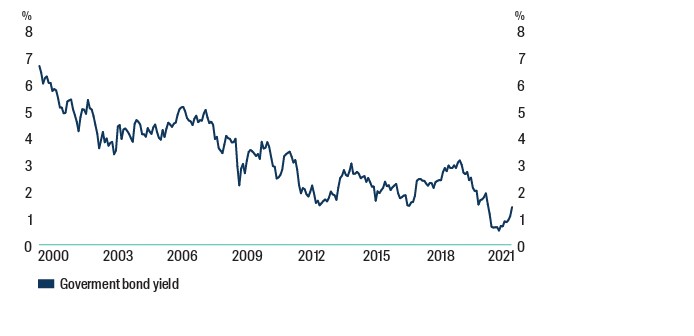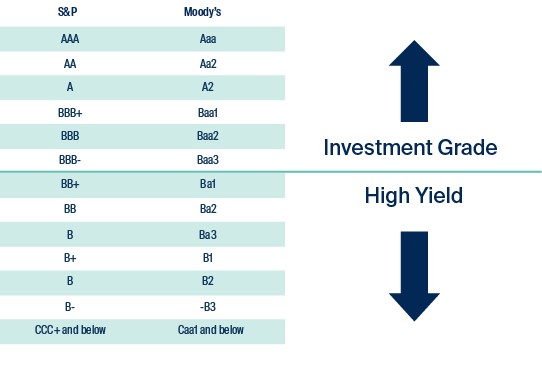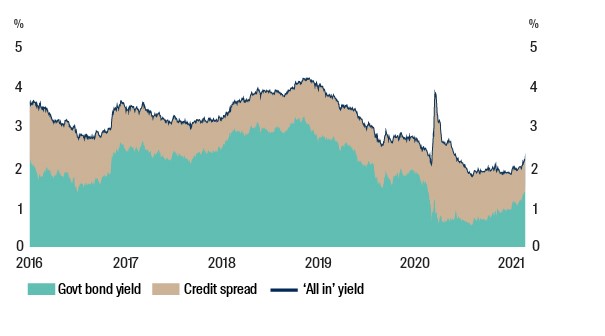Income-seeking investors all appear to be asking the same question: “With prospective returns from defensive assets currently so low, how can I generate any meaningful income from my investments?”
It is a fair question, and one that is not easily answered. In short, the pursuit of higher yields means investors need to look slightly higher up the risk spectrum at asset classes such as credit.
First Sentier Investors is well-placed to assist here. We have been managing Global Credit funds for more than 20 years and have the expertise and know-how to manage portfolios through the full credit cycle. The strategy has generated returns consistently above those on offer from cash and term deposits, and may be an option for yield-starved investors to consider1.
We understand that many investors are unfamiliar with the asset class and have prepared this paper as an introduction to credit securities and the factors that influence their performance.
Fixed Income 101 – what is a bond?
Note: those familiar with government bonds and the risk-free rate can skip ahead to the ‘Higher yielding bonds’ section, where we start talking about credit specifically.
Bonds are issued by a wide range of borrowers, with the proceeds of the bond sales used as a source of funding. Bonds have a fixed face value (or par value) and a predetermined maturity date. A new 5-year bond issued in April 2021, for example, will mature in April 2026. At that time, the face value of the bond – known as the principal – is repaid in full to the bondholder.
Like shares, bond ownership is transferable. Bonds are bought and sold on the open market, providing live pricing transparency. Prices can fluctuate during the life of the bond, but will generally gravitate towards the par value as the maturity date approaches. Most bonds also provide income payments – known as coupons – at regular intervals during their life, often twice a year. These coupons provide investors with stable and predictable sources of income. This helps explain why bonds are popular among investors with known cash flow requirements, as they can match their liabilities with income received from coupons and bond maturities. Historically, the performance of bonds has had a relatively low correlation with the performance of growth assets, like equities. Bond prices are also typically less volatile than shares. Most investors with well-diversified portfolios therefore maintain an allocation to bonds, which can help preserve capital during periods of equity market weakness.
The risk-free rate
The yield on government bonds in developed markets is known as the risk-free rate – essentially, it is the rate of interest that can be earned from the most secure investments. No investment is entirely risk free, but bonds issued by governments in developed countries are about as close as we can get.
For simplicity and consistency, investors use the current yield on government bonds as the risk-free rate. As we can see in Figure 1, government bond yields fluctuate over time. In this case, we have shown the yield on 10-year US Treasuries – a commonly-used yardstick for the performance of government bonds globally.
Figure 1: Risk-free rates

Source: Bloomberg. 10-year US government bond yield, 1 January 2000 to 28 February 2021
When government bond yields are reasonably high, incomeseeking investors may be able to generate sufficient income from holding government bonds alone. As we can see in the chart above, 10-year government bonds in the US were yielding more than 6% at the turn of the century, and over 3% as recently as late-2018. But times have changed: yields have come down sharply in the US, as well as in Australia and almost everywhere else. Government bond yields – and returns from cash-based investments like term deposits – have fallen as the global economic outlook has deteriorated and as official interest rates have been cut. In spite of an uptick over the past few months, risk-free rates are currently close to all-time lows2.
Higher yielding bonds
Bonds issued by entities other than governments in the developed world are commonly referred to as credit. Credit issuers include:
– Corporates: Selling corporate bonds provides companies with an alternative to equity-based funding. The corporate bond market is huge: investors can access bonds issued by a very wide range of firms, in most parts of the world and in almost all industry sectors. Corporates can issue bonds denominated in their home currency, or in international currencies to help diversify their investor base.
– Quasi government entities: As well as governments, various government-related entities also issue bonds. Local examples include Export Finance Australia and National Housing Finance and Investment Corporation. Bonds issued by State Governments like New South Wales and Victoria are also classified as quasi government entities, as are governmentrelated companies like Australia Post. These bonds are generally perceived to be a little more risky than comparable securities issued by governments themselves, but still tend to be regarded as relatively secure due to implicit government support.
– Emerging markets: Governments in developing countries can issue bonds, normally in their local currency or in US dollars. These are categorised as credit securities, because they are riskier than bonds issued by governments in developed countries.
– Securitised: These are essentially pools of other underlying financial assets, which are combined to create new securities. Thousands of residential mortgages, for example, can be pooled together and carved up to form new securities, which are then sold to investors. In the remainder of this paper we focus primarily on corporate bonds, because our Global Credit strategies are predominantly focused on this part of the market.
Default risk
Lending to companies and other credit issuers is generally perceived to be riskier than lending to governments in developed countries. Companies, for example, are more likely to experience cash flow difficulties and may struggle to meet their repayment obligations. They might miss a regular coupon payment, or be unable to repay the bond principal in full at maturity. A failure to fulfil either of these obligations is known as a default.
All credit securities have some level of embedded default risk. To entice investors and to compensate them for this default risk, credit securities offer yields over and above the risk-free rate. This premium is known as the credit spread. The size of the spread differs among individual issuers and can vary over time as the perceived level of risk changes.
Credit ratings
To help investors approximate the level of risk inherent in each, credit securities are assigned ratings by independent agencies like Standard & Poor’s and Moody’s. Credit ratings are determined by the perceived risk of the issuing entity defaulting on its debt. There is a further segregation between investment grade issuers (higher quality) and high yield issuers (more speculative).
Figure 2: Credit ratings and quality bands

Within the corporate bond space, credit spreads are typically lowest among the most highly-rated firms, and tend to be higher for less mature, more speculative companies. The higher yields are required to attract investors. As a rule of thumb, the lower the credit rating, the higher the yield, and vice versa. Credit ratings and spreads are important, as they influence a corporate bond’s overall yield and, in turn, its price. As shown in Figure 3 below, a corporate bond’s ‘all in’ yield is comprised of the risk-free rate and the credit spread.
Figure 3: Deconstructing corporate bond yields

Source: Bloomberg. 10-year US government bond yield, 1 January 2000 to 28 February 2021
As we mentioned earlier, the size of the credit spread fluctuates over time, influenced by the evolving level of perceived default risk. In Figure 3 on the previous page, we can see a spike in credit spreads – the tan shaded area in the chart – in early 2020, when the Covid pandemic started to dominate attention and influence asset valuations.
Remember, bond yields and prices are inversely correlated, so the rise in corporate bond yields at that time due to the higher credit spread saw bond prices fall. In a nutshell, the perceived risk of owning corporate bonds increased and prices moved accordingly. The higher spread saw the ‘all in’ yield from investment grade credit – the dark blue line on the chart – briefly rise above 4%, close to its highest level over the past five years.
Those higher yields were not on offer for long. Corporate bond prices have rebounded in recent months and the ‘all in’ yield is now down to around 2.3%3– close to a record low. Credit spreads narrowed as the initial virus-related panic abated and as investors looked forward towards a normalisation in activity levels and company profitability.
The drop in risk-free rates has also helped push ‘all in’ corporate bond yields lower. Despite a recent uptick, government bond yields have fallen over the past two years – the green shaded area in the chart – primarily because central banks have slashed official interest rates to help economies withstand virus-related slowdowns.
All of that leads us to two important questions: 1) does today’s yield of around 2.3% offer reasonable value for investors; and 2) does credit warrant a place in an investment portfolio given current valuations?
We have prepared a second paper, which answers both of these questions in detail. This is available on our website.
Types of credit funds
Those keen to generate income through credit can choose between many different strategies. People generally obtain exposure to credit through a professionally managed fund, most of which allocate capital across a broad range of credit securities to help diversify risk. Only large, institutional investors tend to own individual credit securities directly.
Like equity funds, credit funds can be managed either actively or passively. In the active space, managers buy and sell individual credit securities aiming to outperform a particular credit benchmark, or to achieve a particular return target; perhaps 1.5% above the risk-free rate. Passive managers aim to match the performance of a benchmark through index replication. There is likely to be some performance dispersion between regions, industry sectors, and among individual issuers. That is completely normal and, in our view, supports the case for active management in this asset class. In fact, a degree of performance variation is welcome, as it provides opportunities to add value to credit portfolios through diligent credit research and active issuer selection.
Some credit funds have an explicit sustainability bias, where Environmental, Social and Governance issues are considered within the investment process. These products might choose not to invest in securities issued by firms in particular industry sectors, for example, or employ some kind of screening process to identify companies with particular ethical characteristics.
Funds can focus on investment grade securities only, or can have the flexibility to invest in both investment grade and high yield bonds. An allocation to the high yield sub-sector can potentially broaden the overall diversification of a credit portfolio, providing exposure to issuers in niche industry sectors that may not be well represented in the investment grade universe. The higher prospective yields in this part of the market can improve potential returns, but also increase the overall risk profile. The higher default risk inherent in high yield credit can also result in more volatile performance outcomes.
There is one more important distinction between different credit funds.
The performance of some is driven by changes in ‘all in’ yields, comprised of movements in government bond yields as well as credit spreads. These funds have typically fared well over the past couple of years as government bond yields have fallen, but an anticipated increase in risk-free rates over time could potentially act as a headwind in the future.
Other funds remove interest rate risk, either focusing on floating rate securities or hedging through the use of derivatives. This means movements in risk-free rates have a limited bearing on performance outcomes. Our flagship global credit strategy is managed in this way. With interest rate risk hedged, movements in credit spreads are the primary driver of returns.
More than two decades of expertise
First Sentier Investors has been constructing global credit funds for more than 20 years, so we have the expertise and know-how to manage investment risks over the full credit cycle.
For value-adding opportunities within the asset class, we believe First Sentier Investors is among the most conservative credit investors in the Australian peer group. We understand that a credit allocation sits within the defensive component of most investors’ portfolios, and is intended to provide some offset to potential volatility in growth assets. Accordingly, capital preservation is of paramount importance in our Global Credit strategy. We invest a lot of time and energy researching issuers and monitoring their performance, to help detect any early signs of stress. The intention is to remove deteriorating issuers from portfolios before valuations are meaningfully affected. Responsible investment considerations form an important component of the research and investment processes. Environmental, Social and Governance risks and how they are being managed by issuers help influence the assignment of internal credit ratings, which in turn drive portfolio construction decisions.
More information on our credit research process is available here.
1. Past performance is not an indicator of future performance
2. As at 28 February 2021, source: Bloomberg.
3. As at 28 February 2021, source: Bloomberg
Important Information
This material has been prepared and issued by First Sentier Investors (Australia) IM Ltd (ABN 89 114 194 311, AFSL 289017) (Author). The Author forms part of First Sentier Investors, a global asset management business. First Sentier Investors is ultimately owned by Mitsubishi UFJ Financial Group, Inc (MUFG), a global financial group. A copy of the Financial Services Guide for the Author is available from First Sentier Investors on its website.
This material contains general information only. It is not intended to provide you with financial product advice and does not take into account your objectives, financial situation or needs. Before making an investment decision you should consider, with a financial advisor, whether this information is appropriate in light of your investment needs, objectives and financial situation. Any opinions expressed in this material are the opinions of the Author only and are subject to change without notice. Such opinions are not a recommendation to hold, purchase or sell a particular financial product and may not include all of the information needed to make an investment decision in relation to such a financial product.
To the extent permitted by law, no liability is accepted by MUFG, the Author nor their affiliates for any loss or damage as a result of any reliance on this material. This material contains, or is based upon, information that the Author believes to be accurate and reliable, however neither the Author, MUFG, nor their respective affiliates offer any warranty that it contains no factual errors. No part of this material may be reproduced or transmitted in any form or by any means without the prior written consent of the Author.
Get the right experience for you
Your location :  Australia
Australia
Australia & NZ
-
 Australia
Australia -
 New Zealand
New Zealand
Asia
-
 Hong Kong (English)
Hong Kong (English) -
 Hong Kong (Chinese)
Hong Kong (Chinese) -
 Singapore
Singapore -
 Japan
Japan























 United Kingdom
United Kingdom 